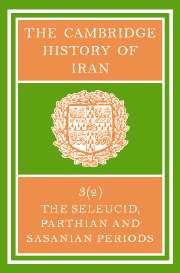Book contents
- Frontmatter
- PART 5 INSTITUTIONS
- PART 6 RELIGIOUS HISTORY
- 22 DEVELOPMENT OF RELIGIOUS THOUGHT
- 23 ZOROASTRIAN RELIGION
- 24 JEWS IN IRAN
- 25 CHRISTIANS IN IRAN
- 26 BUDDHISM AMONG IRANIAN PEOPLES
- 27(a) MANICHAEISM AND ITS IRANIAN BACKGROUND
- (b) MAZDAKISM
- PART 7 ART HISTORY
- PART 8 LANGUAGES AND LITERATURE
- PART 9 BIBLIOGRAPHY
- Bibliography
- Index
- Index of Greek words
- References
25 - CHRISTIANS IN IRAN
from PART 6 - RELIGIOUS HISTORY
Published online by Cambridge University Press: 28 March 2008
- Frontmatter
- PART 5 INSTITUTIONS
- PART 6 RELIGIOUS HISTORY
- 22 DEVELOPMENT OF RELIGIOUS THOUGHT
- 23 ZOROASTRIAN RELIGION
- 24 JEWS IN IRAN
- 25 CHRISTIANS IN IRAN
- 26 BUDDHISM AMONG IRANIAN PEOPLES
- 27(a) MANICHAEISM AND ITS IRANIAN BACKGROUND
- (b) MAZDAKISM
- PART 7 ART HISTORY
- PART 8 LANGUAGES AND LITERATURE
- PART 9 BIBLIOGRAPHY
- Bibliography
- Index
- Index of Greek words
- References
Summary
THE HISTORY OF CHRISTIAN EXPANSION IN IRAN
It will always be difficult to form a clear picture of the initial stages of a religion, however much one may know of the revolutionary character of the founder's circumstances and basic religion. It is quite a long process for a new religious society to free itself of the old traditions, to create its own image and to justify its claim to independence. Christianity is no exception in this respect. To the Romans, for example (cf. Suetonius and Tacitus), it was scarcely more than an episode in the history of Jewry, an internal Jewish problem giving rise to disturbances which had regrettable political consequences for the Romans. Nevertheless, the young Christianity very soon became a missionary church whose history is recorded in the Acts of the Apostles. It is clear that this missionary work soon made a lasting mark. As early as the beginning of the 2nd century, the Younger Pliny, the imperial representative in the province of Bithynia and Pontus in Asia Minor, found it necessary to write (x. 96) to Trajan for advice concerning the treatment of the Christians. At about the same time, Tacitus (Annals xv. 44) records that the “pernicious superstition” (exitiabilis superstitio) had spread to Rome itself (per urbeni), One should be cautious, however, in assessing the extent and influence of these first communities, and even more so in evaluating the missionary activities in the Euphrates-Tigris area. It is only necessary to establish that Christian groups existed in these parts of the empire at an early date.
- Type
- Chapter
- Information
- The Cambridge History of IranSeleucid Parthian, pp. 924 - 948Publisher: Cambridge University PressPrint publication year: 1983
References
- 13
- Cited by



